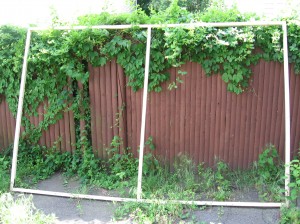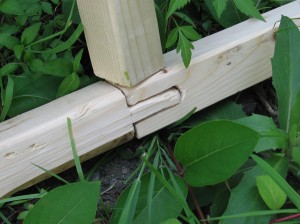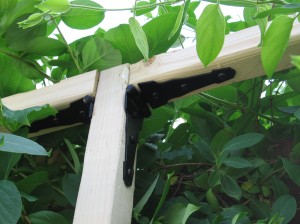Recreational research into Feudal Japan
Posts tagged SCA
Hut in Progress
Jun 5th (a Tomobiki (友引))
I’ve long planned on making a hut based on the one described by Kamo no Chōmei in his An Account of a Ten-Foot-Square Hut, and I’ve finally put some actual time into building it. Chōmei, after a political failure, fled the capital to become a Buddhist hermit, and while doing so wrote an account of his way of life that’s both widely acclaimed in Japan (and often compared to Walden) and handy for anyone trying to recreate such a setup. His hut is actually described as being collapsible, with hinges, for easy transport, and while mine is based more around what I can get for cheap at Home Depot than precise levels of authenticity, that is the right spirit for a SCA structure. I probably won’t have it done for Pennsic this summer, but nothing’s impossible. So far, I’ve got the frame for one wall, and it seems to be working pretty reasonably.
I’ll post some detailed instructions when I’m done, but here are some tidbits so I don’t forget.
- I seem to drill my holes with enough randomness that I can put two screws longer than half the thickness of my wood directly opposite each other without them hitting.
- If at all possible, orient your wood such that you’re not drilling through a knot.
On Making Kimono
Aug 15th (a Shakkō (赤口))
One of the classes I enjoyed this week at Pennsic University was Lady Roxanne’s Guide to Sewing Kosode and “Kimono” (handout soon to be available online at Yama Kaminari). I learned how to make kimono many years ago from my friend Chisato, and have made some modifications along the way, so I thought I’d post some responses. I highly recommend the class and handout; her similar class on hakama, which I caught last year, is also very useful.
Comments, in no particular order:
Neck Drop
I tend to do a less deep neck drop for my under layer kosode, to encourage it to be visible under an over layer. I know lots of people skip the under layer or use a fake collar for the effect, but I don’t tend to find two layers too hot. Then again, I often skip the pants, which is more appropriate for a monk than for a samurai.
Backseams
Lady Roxanne’s instructions leave you without a back seam. Back seams would have been necessary in period, due to narrow looms. They are also ‘traditionally’ associated with protection with evil spirits, but it’s unclear whether this is a product of more recent times, when they are no longer demanded by the fabric, or whether this tradition goes back further. The charms used for protection on backseamless kimono (such as those made for children) are cute, but I don’t know of any premodern examples.
Interestingly, Lady Roxanne does stick to traditional fabric widths for her sleeves, making them from a full panel and a half panel instead of a 1.5-panel width piece. I’ve been known to be lazy and skip seams in both places, but as far as I know there’s no mythology in sleeve seams.
Neck Hole
Lady Roxanne has you cut a semiellipse-shaped neck hole. Chisato’s method used a rectangular neck hole that has always made sewing on the collar a pain. I’d started rounding the corners of the neck hole to improve on this, but I bet using the semiellipse would make this work better.
Stitching
As Lady Roxanne mentioned in class, kimono would traditionally be unstitched to wash and the resewn. Kimono also had loose stitching because, if the kimono were to catch on something, it would be better for the stitching to come out (easily repairable) than for the fabric to rip. As someone whose kimonos have ripped many a time, this effect is hard to replicate on a sewing machine, but it’s something to keep in mind, at least when hand-sewing.
Collars
I like Lady Roxanne’s method of hand-sewing-on the collars and sewing them on the very edge of the fabric, to keep the quarter inch or so between a machine-sewed line and the edge from flipping up, like mine tend to do.
I also have the exact problem with short collars that Lady Roxanne mentions, and using long collars that go most of the way to the ground (instead of my current collar-to-the-end-of-the-diagonal) seems likely to fix it well. This is especially a problem when I wear my underkosode without an over layer (with hakama informally, or as part of a LARP costume), because of the reduced neck drop I do with underkosode.
Armpits
Lady Roxanne mentioned that most people seem to prefer closed armpits. I actually really like open armpits hot places (like Pennsic) so I can avoid my armpits getting all hot and sweaty; I was recently annoyed that I didn’t make the armpit holes big enough on my new underkosode. Open armpits also allow more freedom of motion.
Material
I recommend linen as being an easier-to-obtain fabric that is similar to the authentic hemp. Cotton is both rare in period and breathes less well. Of course, silk is also great and authentic.
Quilting
Lady Roxanne mentioned that the quilted kimono she has seen have quilting visible from the inside only. That’s good to know, since I’ve been thinking of making an actual Japanese warmth layer one of these days instead of just borrowing cloaks from people all over the place.
Overlap Pieces
I have a way of doing the front overlap pieces that saves fabric, if you know the angle you want to cut the front ahead of time, but is more complicated to explain. Instead of doing two full-height half-panel overlap pieces, leave yourself a single half-panel length. (Twice the kimono height minus neck drop is more than enough, but if you’re like me and want to use every part of the buffalo you can do this without cutting this piece to length.) Pin this piece to one side of the front, even at the bottom, and then draw and cut the angle for that half. Flip the remainder and it’ll be the right angle to attach on the other side. Note that this will do the wrong thing if your fabric has a vertically directional pattern, because one side’s overlap piece will be upside down relative to the other.
Sleeves
If you’re using pocket sleeves, be aware that things can fall out the back of the sleeves. With open armpits, sew up the back of the sleeve like you do on the front to make the pocket. I’m not sure how best to do this with closed armpits; you could sew a short seam between the sleeve and the body, but I’d worry that this would restrict arm motion.
I believe monkish overkimono would often have two-full-panel-width sleeves, so you could put your hands together completely covered by sleeve when praying in the cold. I think they also stayed larger-diameter as samurai sleeves became smaller and more practical.
I’d highly Lady Roxanne’s classes to anyone interested in making their own Japanese garb. She’s a great teacher and has ample experience. The handout’s great, but it doesn’t do her justice.
If you’re interested in more kimono references, you may wish to check out my Japanese garb page at The Academy of Seven Monkey, updated to include some links Lady Roxanne mentioned in class.
Auspicious Days, a dissenting view
Aug 4th (a Daian (大安))
A while back I talked about auspicious days and directions. I recently came upon a counterpoint reflecting the practical aspects of military thought. This is one of the seventeen testaments of Asakura Toshikage, one of the first Sengoku daimyō, the great lords of the Warring States period.(SoJT:429)
It is extremely regrettable if a commander, when fighting a battle that can be won or laying siege to a castle that can be taken, should change his time schedule after choosing an auspicious day and considering which directions are good and which are bad. But if a commander, disregarding auspicious days and favorable directions, assesses in detail the realities of the military situation, lays detailed plans for attacking, responds flexibly to circumstances as they present themselves, and maintains his basic strategy, he is sure to be victorious.
As I’m off to Pennsic War this week, I’ll be sure to follow this advice and completely ignore auspicious days while there. Now, back to packing.
Period Award Scrolls
Jul 9th (a Tomobiki (友引))
Just a quick one this week, since I’m off to the war. I was looking through translated excerpts of the Nihon Shoki(SoTJ:48), and I came across some imperial edicts very similar in style to the award scrolls used in the modern Society for Creative Anachronism. Since the Nihon Shoki, as an early Nara period work, is written in Classical Chinese, I’m not going to even consider trying to put together a parallel translation. These edicts are attributed to the Empress Shōtoku.
Notable in this edict are the focus on family merit over individual merit, reflecting the clan-oriented nature of Japanese society, and the focus on both religion and on engineering.(SoTJ:48)
It being my desire to encourage the Inner Doctrines, I was about to erect a Buddhist temple, and for this purpose sought for relics. Then thy grandfather, Shiba Tattō, offered me relics. Moreover, there were no monks or nuns in the land. Thereupon thy father, Tasuna, for the sake of the Emperor Tachibana no Toyohi, took priestly orders and reverenced the Buddhist law. Also thine aunt Shimame was the first to leave her home and, becoming the forerunner of all nuns, to practice the religion of Shākya. Now we desired to make a sixteen-foot Buddha and, to that end, sought for a good image of Buddha. Though didst provide a model which met our wishes. Moreover, when the image of Buddha was completed, it could not be brought into the hall, and none of the workmen could suggest a plan for doing so. They were, therefore, on the point of breaking down the doorway when thou didst manage to admit it without breaking down the doorway. For all these services of thine, we grant thee the rank of Dainin, and we also bestow on the twenty chō of paddy fields in the district of Sakata in the province of Afumi,
This next one has more political subtext, and also shows how much those who notionally retired from political life to become monks or nuns could retain political influence.(SoTJ:119)
It has been represented to us, in view of the master’s constant attendance on us, that he has ambitions of rising to high office like his ancestors before him, and we have been petitioned to dismiss him from our court. However, We have observed his conduct and found it to be immaculate. Out of a desire to transmit and promote Buddha’s Law, he has extended to us his guidance and protection. How could we lightly dismiss such a teacher?
Although our head has been shaven and we wear Buddhist robes, we feel obliged to conduct the government of the nation. As Buddha declared in the Sūtra, “Kings ye who take up thrones, receive the ordination of the bodhisattvas!” These words prove that there can be no objection even for one who has taken holy orders in administering the government. We deem it proper therefore, since the reigning monarch is ordained, that the chief minister should also be an ordained monk. Hearken, all ye people, to our words: We confer on the Master Dōkyō the title of chief minister and master, though the title is not of his seeking.
And with that, I’m off. Mata raishū!



